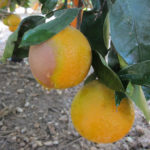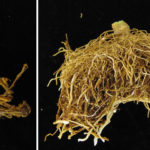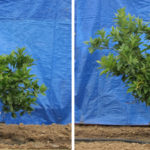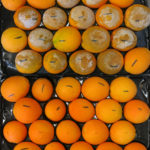The United States is the third largest foreign orange exporter to China after South Africa and Egypt. California traditionally ships more fresh citrus to China than any other state. California Citrus Mutual reported that in 2017, the amount of California citrus exported to China totaled 143,058 metric tons. This included nearly 7.9 million cartons of oranges and lemons.

A worldwide disease problem
Growers and shippers who intend to export fruit to China must comply with phytosanitary requirements for several diseases including Phytophthora brown rot of citrus.
“Phytophthora diseases of citrus are a worldwide problem,” said Dr. Jim Adaskaveg, professor and plant pathologist at the University of California-Riverside. “There is a complex of species involved with Phytophthora citrus diseases. There are some unique species for different geographical regions and seasons.
“Phytophthora species may cause root rot disease, damage to tree trunks as canker-causing fungi and fruit rot. For these disease phases, the same or different species may be the causal pathogens. Several species may occur in the same orchard, but there are differences among citrus growing regions.”
California citrus growers were told that their export market to China for fresh fruit was going to be closed because Chinese officials said they had detected two Phytophthora species they claimed weren’t in their country. In 2014, China closed the market for California fresh citrus based on its quarantine laws.
“California growers wanted to work on controlling the disease from the pre- and postharvest aspect,” Adaskaveg said. “Phytophthora species live in the soil and cause root rot. If the fungus isn’t managed in the soil, it can splash up from the soil onto the low hanging fruit on the tree canopy and this is one way that fruit rot may occur.”

Finding additional controls
Adaskaveg said citrus growers were finding it more difficult to control Phytophthora because of fungicide resistance.
“We knew there was fungicide resistance because many citrus growers were only using phosphonate fungicides such as potassium phosphite,” he said. “Additionally, copper-containing fungicides are registered for use on citrus, but there are concerns with their over application for controlling fruit rots. With the requirements the Chinese were imposing on the citrus industry, there were concerns about the overuse of copper products. Copper is a metal and it can persist in the soil or run off into watersheds. Because of the concerns with overuse and pathogen resistance to existing fungicides, the Citrus Research Board wanted us to look for new active ingredients for the management of Phytophthora diseases of citrus.”
IR-4 Project looks to expand label use
Adaskaveg submitted a request to study the label expansion of the fungicide mandipropamid for Phytophthora control on citrus to IR-4 Project in 2013.
“The request for mandipropamid on citrus was made for control/suppression of Phytophthora brown rot caused by a number of Phytophthora species,” said Kathryn Homa, Plant Pathology Coordinator at IR-4 headquarters. “The issue with this disease is that symptomless fruit at harvest may be mixed with healthy fruit. The pathogen then spreads quickly from fruit to fruit in storage and during transit. Also, when fruit become infected with Phytophthora, they become more vulnerable to secondary pathogens, such as Penicillium species. When fruit are contaminated with these pathogens, they cannot be exported to other countries.
“Mandipropamid is a reduced-risk fungicide that has both preventive and curative properties in controlling oomycete pathogens. It is a very effective product when compared to other registered fungicides. Mandipropamid also provides an alternative to excessive copper use.”
Adaskaveg conducted Phytophthora control trials with mandipropamid at research farms owned by the University of California. IR-4 trials with mandipropamid were also conducted on citrus in other states including Florida and Texas.

An additional tool for IPM programs
Homa said EPA designated mandipropamid a reduced-risk pesticide based on its chemistry.
“EPA expedites the review and regulatory decision-making process of conventional pesticides that pose less risk to human health and the environment than existing conventional alternatives,” she said. “The goal is to quickly register commercially viable alternatives to riskier conventional pesticides.
“The reduced risk decision at EPA is based on comparisons between the proposed use of mandipropamid and existing alternatives currently registered on a crop. Mandipropamid demonstrates high efficacy and prolonged control and serves as an alternative to copper products. This is important since the citrus industry is facing more restrictions on domestic copper use both at the federal and state levels. Mandipropamid would allow citrus fruit to reach near zero detection of quarantine pathogens upon arrival with U.S. trade partners.”
Homa said other chemical controls that can be rotated with mandipropamid include: fosetyl-Al, phosphorous acid, mono- and dibasic sodium, potassium and ammonium salts, copper products, and mefenoxam.
Adaskaveg said that in addition to chemical controls, citrus growers have implemented cultural practices to manage Phytophthora brown rot including skirting the trees.
“Skirting involves removing the lower branches that hang down toward the ground,” he said. “Growers prune the lower branches to at least 20 inches above the soil surface so the Phytophthora pathogen cannot be splashed up from the soil onto the fruit. Fruit below the 20-inch mark are harvested into separate bins and go to different markets. These strategies are to ensure that the highest quality fruit without Phytophthora goes to our international trade partners.”

Expanded use of mandipropamid on other crops
Adaskaveg said he expects the registration of mandipropamid will be expanded with other IR-4 studies because the chemical has activity on Phytophthora and downy mildew pathogens.
“There are other tree crops in California where mandipropamid has application,” he said. “We are doing studies on almonds, cherries and avocadoes. Those are the other three big crops in California that get Phytophthora diseases. With those crops, Phytophthora species are primarily causing root rot diseases and crown diseases. For these diseases, mandipropamid applications would be made as soil drenches.”
Homa said IR-4 has also done research projects on mandipropamid for other crops that are now labelled. These include downy mildew on basil, Phytophthora pod rot on snap beans, Phytophthora root rot and Pythium diseases on ginseng and Phytophthora infestans, which causes late blight on greenhouse tomatoes.
For more: Jim Adaskaveg, University of California, Microbiology and Plant Pathology, Riverside, CA 92521; jim.adaskaveg@ucr.edu.
David Kuack is a freelance technical writer in Fort Worth, Texas; dkuack@gmail.com.
